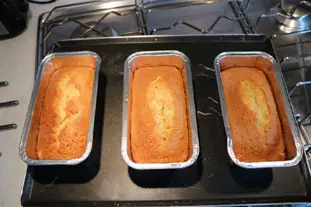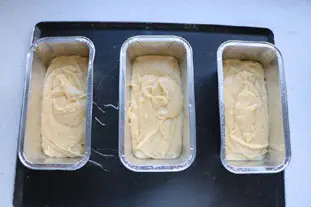This site uses only a few technical cookies necessary for its operation. By continuing to browse, you accept their use.
To find out more...
To find out more...
Baking a cake at the right time

When you make a cake, which most likely contains butter, a cake for example, chances are that as soon as the batter is finished, you put it in the pan and bake it immediately.
Classic, everyone does it like that, and then if, on top of that, you have a few kids around you who are getting impatient, and almost want it to be cooked before going in the oven, when they haven't eaten half of the raw dough before, the pressure is even stronger!
Classic, everyone does it like that, and then if, on top of that, you have a few kids around you who are getting impatient, and almost want it to be cooked before going in the oven, when they haven't eaten half of the raw dough before, the pressure is even stronger!
21 K 4.5/5 (24 reviews)
Keywords for this post:BakingCakeCookingAdviceButterColdLast modified on: April 18th 2020
Baking a cake at the right time

So baking right after you finish kneading your dough is quite classic, but actually it's not a very good thing for two reasons:
1) The butter is often very soft, especially if the kneading was a bit long and heated the dough, which becomes very soft, and if there are additions in it (raisins for example) they will go to the bottom of the pan more easily. How to correct this? Put the dough in the fridge for at least 30 minutes.
2) The gluten contained in the flour (if there is any in your recipe) under the effect of kneading has started to structure itself and "stretches" the dough making it elastic, which is not interesting for a cake because it hinders the rising during baking. How to correct this? Let the dough rest for at least 20-30 minutes.
You will have understood, no need to rush: Knead your dough, put the bowl or the mixer bowl in the fridge for 30 minutes (this is often the opportunity to do a little washing up...) then only then put it in the oven.
Another option, once the dough is kneaded, put it in a mould, then put the mould in the fridge for 30 minutes. Bake then and only then.

To sum up: Before putting a cake in the oven, it is always best to leave it in the fridge for about 30 minutes, as your cake will rise better when baked. In baking, the cold is (almost always) your friend.
Lasts posts
Butter vs. grease
We often read in a recipe where a pastry is put into a mould that, just before pouring, the mould should be buttered or greased. But what's the difference between these 2 terms?December 1st 20259665
Getting out of the fridge early
Very often when you're cooking, you need to take food or preparations out of the fridge, to use them in the recipe in progress. There's nothing tricky about this: you just take them out of the fridge and use them, usually immediately, in the recipe. But is this really a good method?November 24th 20251,0955
Who's making the croissants?
When you look at a bakery from the outside, you naturally think that in the bakery, the bakers make the bread, and in the laboratory, the pastry chefs make the cakes. It's very often like that, with each of these professions having quite different ways of working, but sometimes there's also one...November 23th 2025991
Oven height
When we put a dish or cake in the oven, we naturally tend to put it on the middle shelf, and that's what we usually do. But in some cases, this position and height can be a little tricky, so let's find out why.October 8th 20252,7165
The importance of sieving
In recipes that use a fine powder (flour, powdered sugar, etc.), you'll often see the advice to sift before using it. To sift is to pass the powder in question through a sieve (a very fine strainer) before incorporating it into your recipe. It's often advice, but is it really useful?September 3rd 20257,5213
Other pages you may also like
Candied fruits: don't get ripped off
Do you like candied fruit? You might like to nibble a handful or add it to a recipe, like a classic fruit cake or delicious Italian specialities like panettone or sicilian epiphany pie.June 21th 201767 K 24.2
Drawing a pattern in pastry
Often in the kitchen, in pastry-making, or in baking, we need to trace a pattern on a pastry. It's just a question of aesthetics but it has its effect after baking on a galette, pithiviers, pâté en croute (terrine in a pie crust), etc.May 23th 201935 K4.1
The return of the "Norman hole"
You maybe know the "trou normand", this old gastronomic custom typically French which consists in taking a (small) glass of calvados, generally between the last course and the dessert? It's something that seems a bit anachronistic nowadays, having a glass of an alcohol of more than 60° in the...December 18th 202115 K4.8
A few tips for effective kneading at home
When you have to knead dough for bread or some other recipe, you may well use a food processor or the type of machine known as a stand mixer. The best-known brands are Kenwood and KitchenAid. They are useful tools, but here are a few tips to help you get the best out of them.June 23th 2021284 K 23.8
Baking cakes
Where we see that to put a cake in the oven, once the dough is finished and in its mould, there is no hurry and that the cold is your friend.June 28th 201945 K4.1
Post a comment or question
Follow this page
If you are interested in this page, you can "follow" it, by entering your email address here. You will then receive a notification immediately each time the page is modified or a new comment is added. Please note that you will need to confirm this following.
Note: We'll never share your e-mail address with anyone else.
Alternatively: you can subscribe to the mailing list of cooling-ez.com , you will receive a e-mail for each new recipe published on the site.









